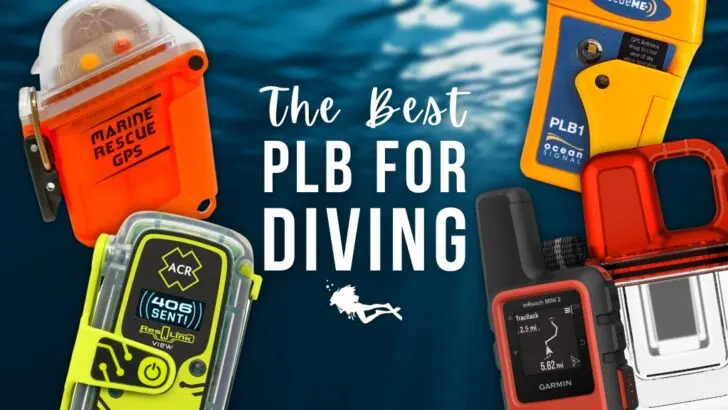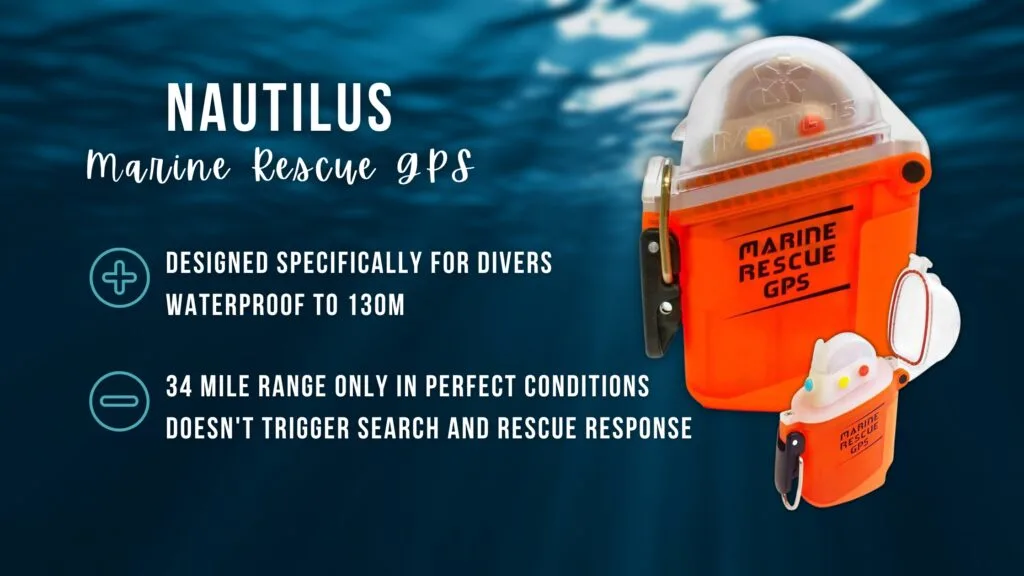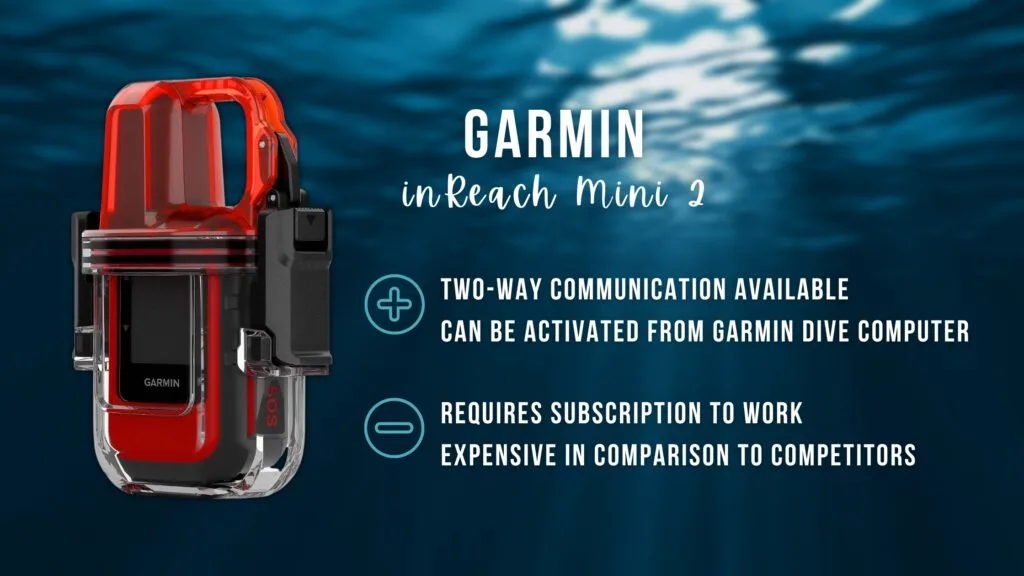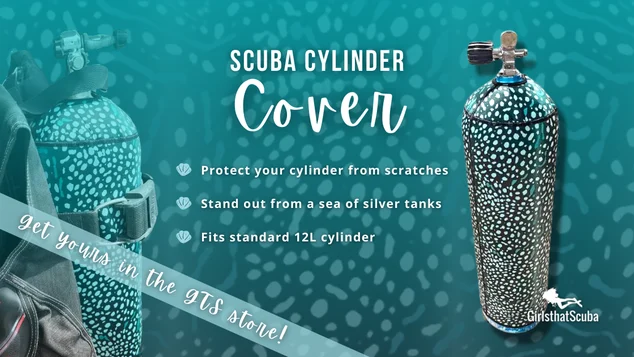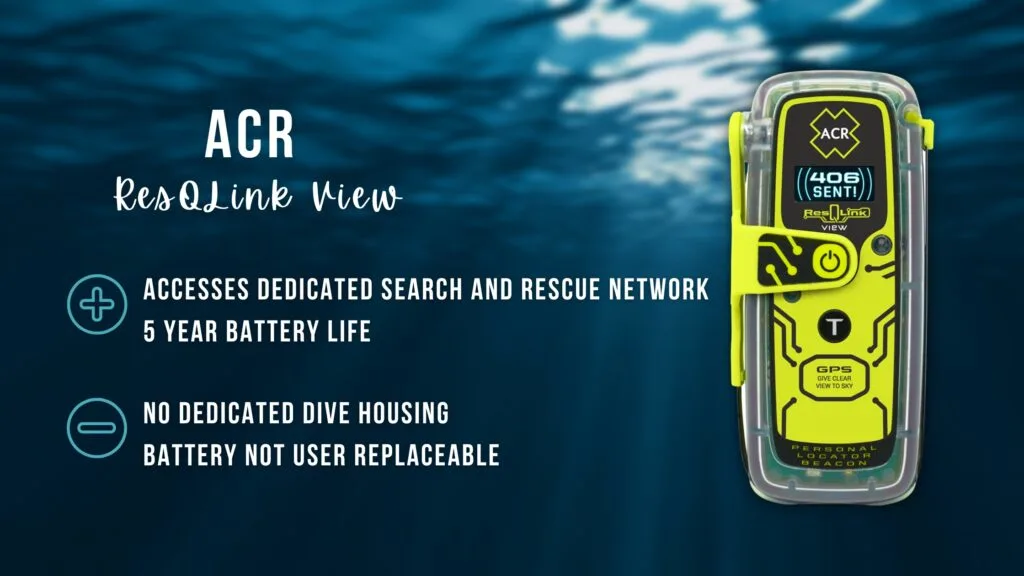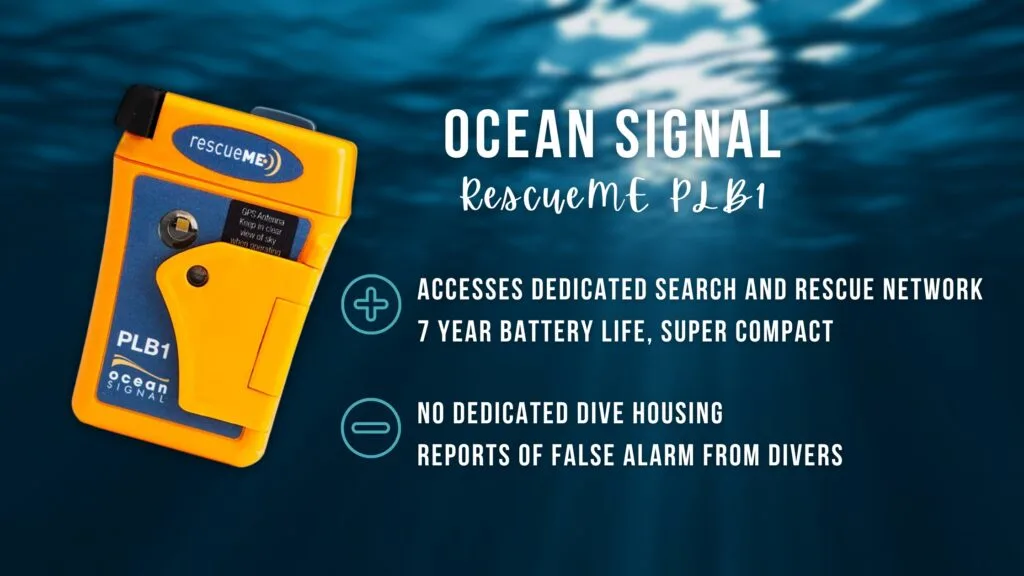Do you know what you would do if you got swept away at the surface? It’s a situation you’d hope to never be in, but carrying a PLB when diving could save your life. So what is a PLB, and which is the best PLB for diving? Read on to find out.
What is a PLB?
PLB stands for Personal Locator Beacon. These are small devices which can be triggered to send out a distress signal in an emergency. They’re often carried by people taking on adventurous activities in remote locations, like hikers or backcountry skiers. Or in our case, divers.
They work by sending out a distress signal on a specific frequency, which is received by a network called SARSAT (Search and Rescue Satellite Aided Tracking). This network then uses the location of the distress signal to alert the nearest appropriate authority. Depending on the situation, this could be emergency services, coastguard, rescue helicopters, etc.
Not all of the devices included in this article are strictly PLBs. However, all of them serve the same purpose of getting help in an emergency.
Why do you need a PLB for diving?
Picture this situation. You experienced a strong current underwater, and sent up your DSMB to show where you were and how fast you were drifting. This was the right thing to do, but you and your buddy still surfaced out of sight of the boat. The surface conditions are challenging, and your DSMB and whistle aren’t enough to get attention from the boat as you’re drifting further away. In this emergency situation, you need another way of contacting help.
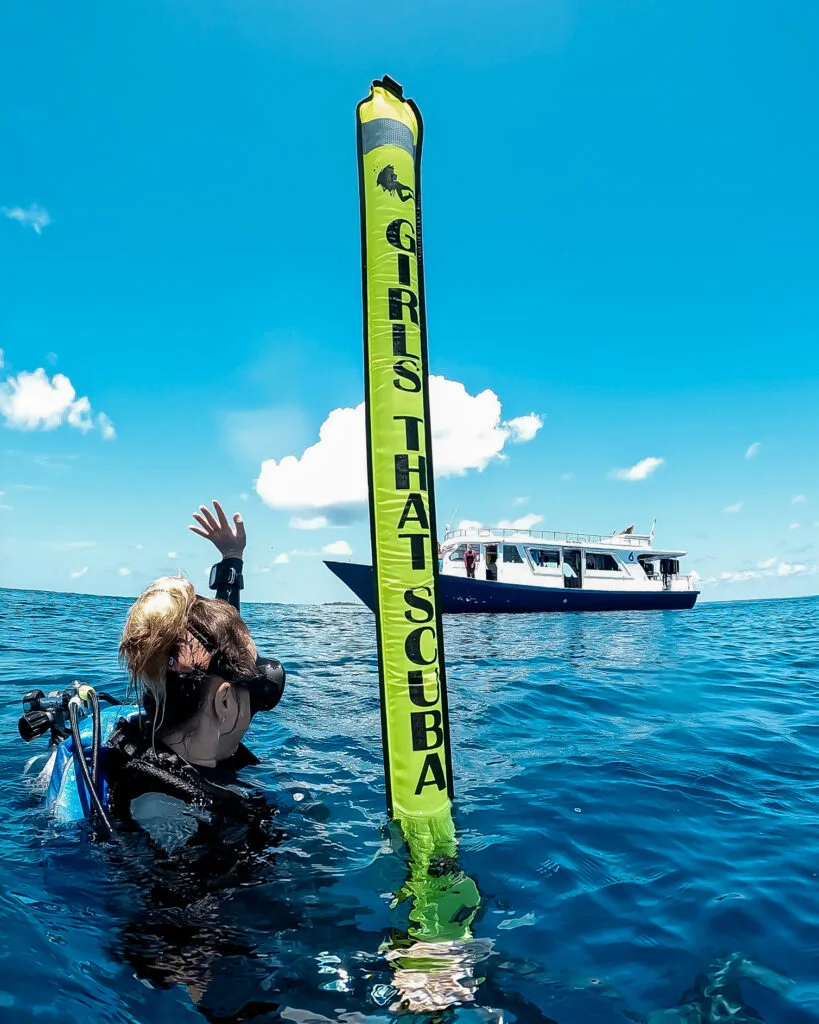
Divers carry these devices in case of being swept away at the surface. They’re particularly useful when diving in remote locations with challenging conditions, such as Cocos Island, Galapagos, Socorro, or Malpelo. Some liveaboards even require guests to have one, or give them to guests to use whilst on board.
Carrying a PLB for diving is a bit like having dive insurance. It’s a piece of equipment you hope to never use, but it could save your life if you find yourself needing it. As divers, we spend a lot of money on dive gear, dive travel, and photography. This is a small investment in something which could save your life.
Nautilus Marine Rescue GPS (Previously Nautilus Lifeline)
This is one of the most common devices of this type used for divers, and it’s not technically a PLB. Unlike any of the other devices in this article, the Nautilus was designed specifically for diving.
The Nautilus Marine Rescue GPS is a personal AIS beacon. When the button is pressed, the Nautilus determines your location using GPS. It then transmits your location and a man overboard distress signal to nearby boats using AIS (Automatic Identification System), which most vessels have. The range of the distress call is up to 34 miles, but this is in ideal conditions.
You may have heard of the older version, the Nautilus Lifeline. This model also had a two-way radio on VHF frequency, allowing divers to talk to rescuers. Some divers prefer the older version but it’s no longer produced. It was also bulkier than the current model.
Pros
- The Nautilus Marine Rescue GPS is specifically designed for diving, so it’s waterproof to 130m (425 feet).
- It is positively buoyant, so the Nautilus will float if you drop it.
- The battery lasts 5 years, and is user replaceable. It takes CR123 batteries which are easily sourced.
- No subscription service is needed, so there are no costs beyond the initial purchase.
Cons
- The claim of a 34 mile range refers to perfect conditions with the antenna being raised up to a significant height above the water. In reality, you’re likely to have a much lower range which could worsen with challenging conditions.
- The Nautilus does not trigger an emergency search and rescue response. If your distress signal isn’t picked up by any nearby boats, it has no other way of attracting help.
- Of all the devices in this article, this is the only one which can solely be used for diving. All of the others can be used for land-based activities too, which may be useful if you have other hobbies.
Garmin inReach Mini 2
The Garmin inReach Mini 2 is another device which isn’t a PLB, but can definitely be used for lost diver situations. Unlike the satellites used by PLBs, the inReach connects to the private Iridium® satellite network.
When the SOS is activated, the device contacts Garmin Response (previously the IERCC, International Emergency Response Coordination Center). The co-ordinators then pass on the relevant information to local authorities. They will also contact your personal emergency contacts, which you can list when you register the device.
Using the Garmin inReach requires the additional costs of a subscription and initial registration fee, but it does have a number of advantages over simpler devices. Subscriptions vary from £12.95-£64.99 per month depending on level of coverage (may also vary by location), and can be paid monthly or annually. You can turn the subscription off for months that you won’t be diving.
Pros
- The inReach Mini has two way communication, which means you can provide extra information to rescue services. However, typing on the device is clunky and involves selecting one letter at a time. This might be fine if you’re being rescued from a hike, but with thick gloves in cold water it would be challenging.
- Garmin did have divers in mind in the design process, as the inReach has a dedicated dive canister which can be taken to 100m (328 feet).
- If you also use a Garmin dive computer (Descent MK2, Descent MK2S, Descent G1), you can activate the inReach from your dive computer without removing it from the housing.
- Can be used for non-diving activities.
- The two-way communication can also be used in non-emergency situations, which may be useful in remote locations with no phone signal. You can also share live tracking of your location, which could be useful for family to see your liveaboard route, for example.
- USB rechargeable with approximately 90 hours battery life (varies dependent on use).
Cons
- Must have a subscription for the device to work.
- The technology uses a private network for rescues (Garmin Response). You may end up with costly rescue fees, so ensure you also have dive insurance to cover any evacuation costs. Garmin do offer an additional form of search and rescue insurance which can cover this.
- You must remember to keep the battery charged. 90 hours is a long battery life in comparison to phones, but short compared to the 5-7 years offered by other rescue devices.
- The inReach Mini 2 is negatively buoyant when outside of the dive case. If you drop it at the surface, it’s gone.
- It’s significantly more expensive than the other devices listed here.
ACR ResQLink View
The ACR ResQLink View is a true PLB. It works as described earlier in the article, by accessing the SARSAT network which is dedicated to rescues.
You must register your device (check what authority depending on location), and you can add information about who you are and what you use the device for. You can change this as needed, so if you use it for land based activities and diving, remember to change the information in between trips.
Pros
- No subscription is needed for the ResQLink to work, you only need to pay the upfront cost of the unit.
- 5 years of battery life.
- Can also be used for non-diving activities.
Cons
- Battery is not user replaceable, the unit has to be taken to a dealer.
- As the product isn’t designed with divers in mind, the ResQLink cannot be taken to depth without a casing. It has a depth rating of 10m (32 feet) for 5 minutes, so is waterproof enough to be used at the water’s surface.
- There is no specific dive housing so you will have to source a dive canister, which may be bulky to attach to your dive gear. However, a larger canister has the benefit of potentially having space for other emergency equipment such as a whistle or foil blanket. We’ve linked some canister options below.
Ocean Signal RescueME PLB1
As with the ResQLink above, the Ocean Signal RescueME PLB1 is a PLB operating on the SARSAT system. Similar to above, you can also fill in your information online to help rescuers identify you and contact your emergency contacts.
Again, this can be updated with specific information from trip to trip. You may want to register what liveaboard you’re diving from, or where you’re diving from if you’re diving independently.
Pros
- No ongoing subscription, just the cost of the unit.
- Waterproof to 15m (49 feet).
- The RescueME is super compact in comparison to other units.
- Can be used for non diving activity.
- 7 year battery life.
Cons
- Negatively buoyant if dropped at the surface, but a float pouch is available.
- No dedicated dive case – must buy a separate canister.
- The battery is not user replaceable. When the 7 years is up, you must take it to a dealer where they can replace the battery and test the functionality.
- There is a possibility of a false alarm. Some dive specific stories report the device being triggered, potentially by pressure at depth, or by dive canisters failing.
Dive Canisters for PLBs
If you choose a PLB like the ACR or RescueME which doesn’t offer a dedicated dive case, you will need a canister to take it on your dives. As mentioned, these can be large and take up some real estate on your dive gear. However, they also give the opportunity to house some extra safety items.
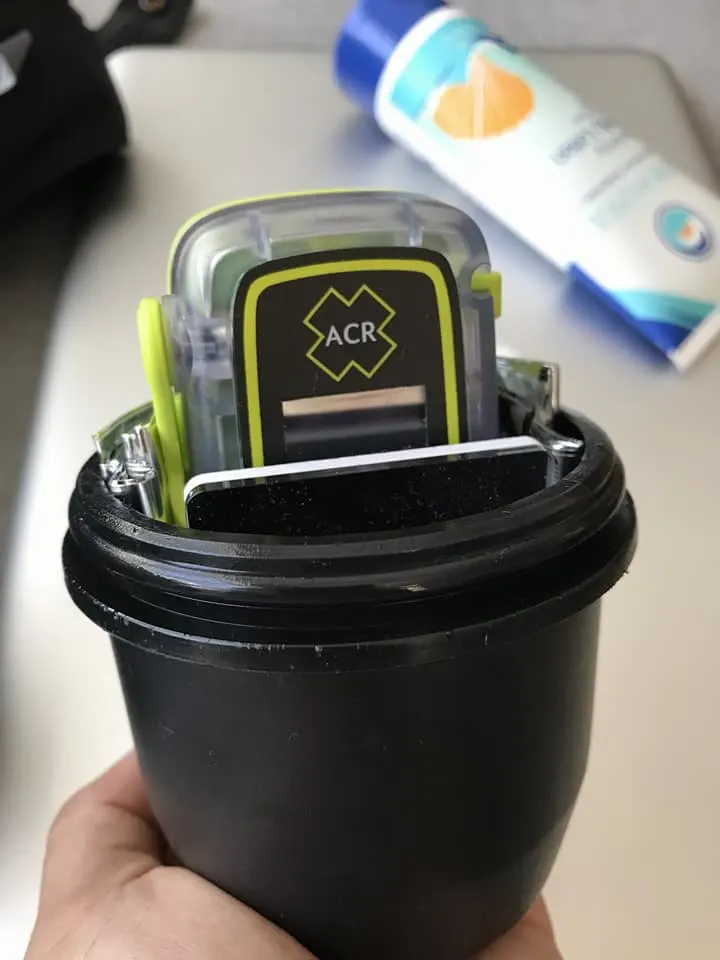

Girls that Scuba Facebook group member Jennifer Hui Cheung kindly shared some images of her PLB setup. She carries the ACR PLB in a canister, which she wears in a Scubapro Cargo Thigh Pocket. The leftover space in her canister comfortably fits a signal mirror, emergency foil blanket, and whistle.
There are lots of options for dive storage canisters out there, but these two brands are designed specifically to fit PLBs. Custom Divers are based in the UK, whilst DRYFOB ships from the US.
Which wins the best PLB for diving?
So what’s the best PLB for diving? Frustratingly, no single product has got it quite right yet. An ideal dive specific device would combine the ability to contact nearby boats (like the Nautilus) with the access to search and rescue satellites (like a PLB or Garmin). If someone’s ready to manufacture it, divers are waiting!
Carrying the Nautilus plus any one of the other devices above would give you the ultimate safety coverage and redundancy. If you dive with a regular buddy, you could diversify your options by having a different device each, although this wouldn’t help in a buddy separation.
Ultimately, carrying any of them is better than none. Whichever you choose, it’s a worthwhile investment in your dive safety.
Do you have a PLB? Share your stories with our Facebook community!

